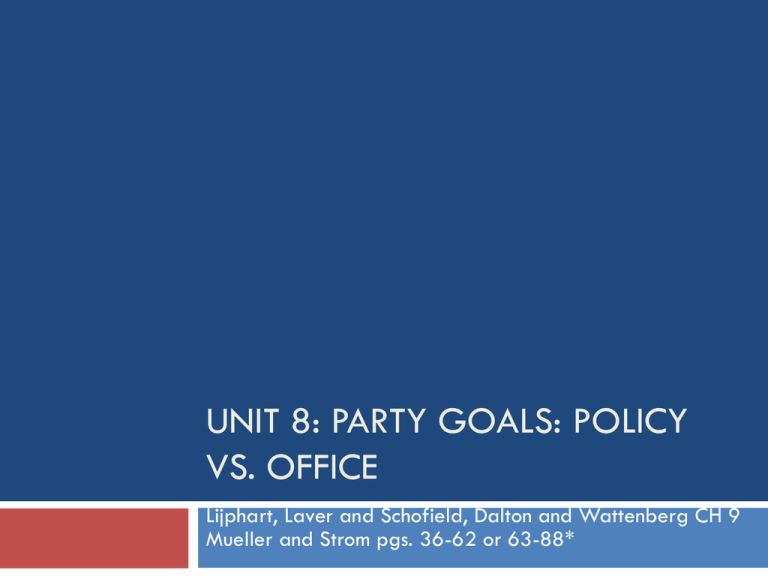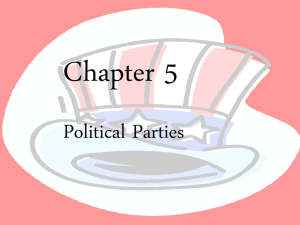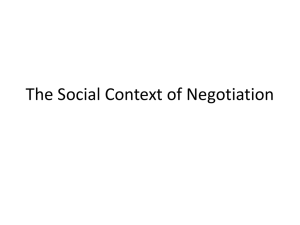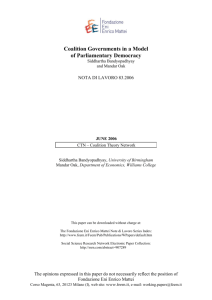Policy vs Office
advertisement

UNIT 8: PARTY GOALS: POLICY VS. OFFICE Lijphart, Laver and Schofield, Dalton and Wattenberg CH 9 Mueller and Strom pgs. 36-62 or 63-88* Guiding Questions What is coalition theory? How do we explain which parties get into government? What do office based theories hypothesize? What do policy based theories hypothesize? Parties at the Center of Government Strom 1999 Democracies vary in terms of how they vest executive and legislative authority Attempt to prevent unchecked executive or legislature rule. Classic theories predicated on the US (presidential) and the UK (parliamentary) models. Parties remain “at the core of government” A long history in political theory. Presidential and parliamentary systems posit very different relationships between the executive and the legislature. Reviewing Presidentialism and Parliamentarism PRESIDENTIALISM President: head of state and head of government Separate origin Executive and legislative branches are elected separately. Both branches are elected for a fixed term. Cabinet members do not sit in the legislative branch. PARLIAMENTARISM Separate survival Neither branch can remove the other except in extraordinary circumstances. Prime Minister: head of government PM/Cabinet-collective executive Monarch/president: head of state Shared origin: Only legislature is directly elected. Terms are not fixed. PM /Cabinet come from the legislature Shared survival: Confidence relationship exists between executive and legislature Confidence Relationship Concept of responsible government defines parliamentary systems. PM and his or her government must have the confidence of the chamber (majority support). Legislature possesses authority to express no confidence in the executive. Governments must resign if they lose a vote of confidence. Executive (PM) has powers of dissolution. PM can typically dissolve the parliament and call for new elections at any time. Strong party discipline is critical in parliamentary systems. Coalition Theory Many parliamentary systems use proportional representation to elect representatives. Coalition theory examines why certain parties enter government and others do not. Following an election there are many possible coalitions. This makes it difficult for one party to win more than 50% of the seats. Parties wishing to enter government have to create a coalition that cannot be defeated on a confidence vote. But not all are feasible. Some parties are always in government while others are always in opposition. Why are certain parties more likely to enter government while others do not seek to enter government at all? Literature offers both office based and policy based motivations for entering government Office Seeking Theories: Minimal Winning Coalitions Von Neumann and Morgenstern 1953 Theory is “policy blind” Conceives of government formation as a zero sum game over the spoils of office Hypothesis: Minimal winning coalitions will form. Minimal winning coalitions: Coalitions where every party is critical to maintaining a majority (i.e. no superfluous parties). Observations: From 1945-1987, 35% of coalitions formed followed this pattern. Office Seeking Coalitions: Minimum Winning Coalitions In large systems, several minimal winning coalitions are possible. How do parties choose between minimal winning coalitions? Riker 1962 Hypothesis: Parties want to boost their bargaining weight within a coalition, thus minimum winning coalitions will form. Minimum winning coalitions: Coalitions consisting of parties with the smallest total weight. Iceland 1983 WL WL-3 SD-6 TOTAL SEATS: 60 37: IP/PP 34: PP/PA/SD/SDF 33: IP/PA; IP/SD/SDF; PP/PA/SD/WL 32: IP/SD/WL 31: PP/PA/SDF/WL 1 minimum winning coalition (minimal winning with smallest weight): PA-10 PP-14 MAJORITY: 31 63 possible coalitions. 7 possible minimal winning coalitions (no superfluous parties): SDF-4 31: PP/PA/SDF/WL End result: IP and PP coalition. IP-23 Office Seeking Theories: Minimal Connected Winning Coalitions Questions of which minimal coalition should be chosen still plagued these theories. Axelrod 1970 Policy “compatibility” reduces the number of viable coalitions and eases bargaining. Hypothesis: Minimal connected winning coalitions will form. Minimal connected winning coalitions: Minimal winning coalitions made up of parties which are ideological “neighbors” Loss of one party leaves a coalition which is either: 1) no longer winning 2) no longer connected Italy 1972 PCI 179 PSI 61 PSDI 29 PRI 15 DC 267 PLI 20 630 TOTAL SEATS-MAJORITY IS 316-3 OTHER 127 coalitions were possible. 3 were minimal connected winning (MCW): PSI/PSDI/PRI/DC PSDI/PRI/DC/PLI DC/PLI/MSI. Any coalition including the MSI or the PCI was not an option. Five coalitions formed before new elections were held. MSI 56 Italy 1972-Revolving Coalitions 1st: DC minority government (267). 2nd: DC coalition (minimum winning-316). 3rd: DC coalition (minimal connected winning-372). 4th: DC coalition (surplus majority-357 seats) 5th: DC minority government (282). Evaluating Office Based Theories Pure office based theories cannot address: 1) Why surplus parties are ever included in a governing coalition? Example: 2) Why minority governments form? Example: Israel Denmark But policy based theories of coalition formation can. Policy Based Theories: Issue Dimensions Laver and Schofield 1998. Parties enter winning coalitions that will adopt their preferred policy. Party controlling the median voter serves as the “pivot” within the legislature. Sees the party holding the median voter as a “policy dictator” Hypothesis: Coalitions will include the party holding the median legislator. Denmark 1966 SFP 20 SD 69 RV 13 V 34 KFP 35 179 SEATS TOTAL. 8 OTHERS. MAJ = 90 The median legislator is a Social Democrat (SD). Any viable coalition would require SD support. Result: SD formed a minority government. Defeating the SD would require parties of the left and the right to coalesce. Unlikely. So a party could govern without holding a majority of seats. Conclusions Median parties are well placed in coalition bargaining talks. Laver and Schofield 1998: More than 80% of coalitions from 1945-1987 included or were supported by the median party. To suggest that parties care about policy does not mean that they do not possess office seeking goals. Understanding government formation requires us to look at BOTH policy and office goals. Case Study: Ireland Examine How the Irish political environment shapes party options. How do Irish parties typically rank policy, office, and votes? Labour’s coalition decisions What were the tradeoffs made between policy and votes in negotiations with Fianna Fail and Fine Gael? Fine Gael’s (FG) Tallaght Strategy What did FG get out of supporting its nemesis in government? Fianna Fail’s (FF) decision to form a coalition. Why did a party that used to govern alone become willing to share the spoils of office? Case Study: Denmark Examine: Why were minority governments so viable within the Danish case? That is, why would a party seek to form a minority coalition? Why would other parties prefer to remain in opposition rather than defeat a minority government? Why do parties prefer to be seen as advancing policy rather than office based motives? Next Lecture Theme: Party Systems Ware pgs. 5-13 Theme: Party Systems (Competition Models) Ware CH 5 Electronic Reserves: Sartori Mueller and Strom pgs. 141-171










